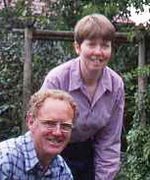It's not just humans flooded out in all this rain - bumble bees are suffering too as they can't fly in heavy rain and their nests (on the ground) are being flooded too. And because of changes in farming practice over the past 50 years, there aren't as many flowers around, so numbers are falling.
So it's good news that gardeners can help with flowers that bumblebees love, often but not exclusively purple-blue ones, and including foxglove, aquilegia, lupins, chives, sage, thyme (in our garden, they love the comfrey that we grow for groundcover). Gardeners can also help out with artificial nestboxes, but need to patient, according to Prof Dave Goulson at Stirling University (home of the Bumblebee Conservation Trust) who's researching the ideal artificial bumblebee nest so gardeners can help survival. He was interviewed on Radio 4's Shared Earth yesterday and explained that bumblebees usually nest in old mouse nests. So although the artificial nests sold at garden centres don't seem to work, if you wait long enough for mice to use them, and then, just as importantly, abandon them, bumblebee queens sniff these sites out and move in. It's all because they can't carry nesting material easily, so have to find a ready-lined place.
You can listen to the programme via the web - just fast forward to around 18 minutes in for the bumblebee bit. The Prof asked listeners to e-mail him with info on successful and unsuccessful bumblebee nests in your garden, but I couldn't find details on the BBC site. However the Bumblebee Conservation Trust website has info on the nest site trial and an e-mail address for your input. The site also has useful lists of flowering plants to grow for bumblebees, plus plenty of other bumblebee bumf. We’ll be adding details of the trust to our list of conservation sites on our Gardening Masterclass site soon too.
Saturday, 14 July 2007
Bumble bees need gardeners
Posted by
Alec and Val
at
09:21
|
![]()
![]()
Labels: conservation, Gardening, wildlife
Thursday, 12 July 2007
Congleton Cycling Campaign
Congleton Cycling Campaign have made their mark on the town by lobbying the local authorities for cycling facilities and devising routes for workers, shoppers and schoolchildren. Their leaflet, Congleton Cycle Network, contains a map of national and local routes through the town, plus contact details for membership - pick it up from the local library or the town's tourist information centre (details on www.congleton.gov.uk).
Map key: National and local cycle networks National and local cycle networks (off road) Congleton cycle network Congleton cycle network (off road) Walk here |
Posted by
Alec and Val
at
16:38
|
![]()
![]()
Labels: carbon footprint, carbon neutral, Cheshire, cycling
Tuesday, 3 July 2007
A new bar in an ancient village
One of the highlights of our visit to the medieval village of Rodemack (Lorraine’s little Carcassonne) was stumbling over a barn conversion with a difference. Tucked away in a back street, it’s a mix of old stonework and contemporary wood, with an eclectic mix of tables and seating to appeal to all ages.
Georges has spent his spare time over the past seven years converting this old building into a place that locals will feel comfortable in whether young or old, because, incredibly for a French village, there was no bar before this opened. Being newly opened, no smoking is allowed inside (established bars will have to toe the line by the end of 2007), but there’s a terrace in the back garden for those in need. And also being new, it is accessible to all – no tricky steps or narrow doors.
Georges has obviously enjoyed creating unique designs – the bar itself is a beautiful mix of different woods; he’s made all the table tops himself from different materials, and his glass-topped tables are works of art. One contains a display of shells and stones from Brittany beaches; the other has a poultry theme (not too sure why) with proverbs, lyrics and jokes. Perhaps that’s why – they’re a source of inspiration. How about this French saying: If you have chicken skin, you need feathers. Lost in translation? Chicken skin=goose pimples.
The background music is familiar – Celtic – not Irish as we first thought, but from Quebec and Brittany (reflecting Georges’ roots). He’s planning to get his musician friends along once the bar’s established….
As Georges has a day job, ‘La Grange à georges’ is only open at certain times:
Wednesday evenings (7pm-1.30am)
Friday afternoons and evenings (1pm-1.30am)
Saturday all day and night (10am-1h30am)
Sundays (10am-8pm)
If you get the chance to go, and it’s quiet, ask to see his recumbent that he designed himself – and check out the front wheel drive.
No need to go thirsty
A Belgian cyclist we met in France reminded us of this tip - if you can’t find anyone to top up your water bottle, then cemeteries are a good bet. There’s nearly always a tap somewhere for people tending the graves.
Churches and cemeteries are marked on UK Ordnance Survey 1: 50,000 (Landranger) and larger scale maps.
1:200,000 and larger scale Michelin maps for France, Belgium and Luxembourg also show cemeteries, but lots of villages have them so you’re bound to pass a few as you cycle around.
Another tip from the Belgian - the sign 'eau non-potable' (i.e. not drinking water) is usually for insurance purposes only. So in most cases, it's safe to drink.
 or for your mobile
or for your mobile
